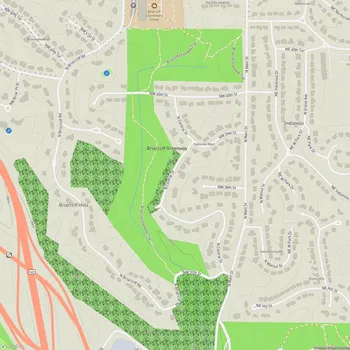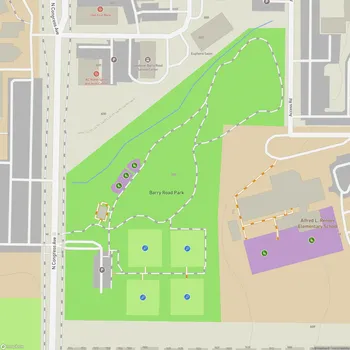Cave Spring Park
Interactive Park Map
About Cave Spring Park
A Journey Through Time and Nature
Tucked away across the Kansas City and Raytown border in Missouri, Cave Spring Park (also known as William M. Klein Park) spreads across 39 acres of historic grounds and natural beauty. As a National Historic Landmark, this park isn't just another green space - it's a living museum where the Santa Fe, Oregon, and California Trails once converged, as a crucial rest stop for weary travelers heading west.
As you wander through the park, you'll stumble upon fascinating pieces of the past - stone chimneys standing like silent sentinels from cabins built about a century ago, a Scout encampment that speaks to generations of outdoor adventures, and an authentic Santa Fe Trail marker that reminds us of the countless wagon trains that rolled through during America's westward expansion. The Cave Spring Interpretive Center houses a treasure trove of historical artifacts, from rustic tools and dishes to vintage photographs, and even features a mock 1850s bedroom complete with an old-school rope frame bed.
Natural Wonders at Every Turn
The park's network of trails stretches over six miles, offering both paved paths for those who prefer easier walking and wood-chipped trails for the more adventurous hiker. The namesake cave is relatively modest and not currently open for exploration, but you can still observe its natural spring flowing outward.
Two man-made lakes dot the landscape, with the larger pond hosting a community of turtles and fish that seem unbothered by curious onlookers. Deer frequently make appearances, and the wildlife sanctuary attracts numerous bird species that birdwatchers will appreciate.
Don't miss the peaceful butterfly garden, the serene water garden, and though it might not rival Niagara Falls, the small waterfall adds a soothing soundtrack to your visit that perfectly complements the park's tranquil atmosphere.
Finding Your Path
The interconnected trail system loops throughout the park in such a way that getting truly lost is virtually impossible - which is always reassuring. Many regulars favor the Truman Trail, a 1.1-mile perimeter loop that brings you right back to the parking area. Most trails are clearly marked, but we should note that some signs might occasionally leave you scratching your head.
The park works well for different activity levels - you can take a short, easy stroll with toddlers in tow or set off on a more ambitious trek through the wooded areas. And when summer heat hits, you'll appreciate the dense tree canopy providing natural air conditioning on even the hottest days.
Far From Just Hiking
Throughout the grounds, you'll find numerous picnic areas with tables conveniently placed near the entrance and along various trails. There's even a unique campfire ring surrounded by benches - well-suited for gatherings or just sitting and soaking in the atmosphere.
While the playground has been removed (with a new one in the works), the park remains incredibly family-friendly. Kids naturally gravitate toward exploration here, climbing over logs and discovering hidden nooks among the trees.
Four-legged family members are welcome too, but they'll need to stay leashed. The wooded trails make for a much more interesting dog walk than your typical neighborhood sidewalk.
Learning Through Experience
The Cave Spring Interpretive Center functions as the educational hub of the park, offering rotating exhibits that dive into the region's cultural and ecological history. While its opening hours are limited, the center provides fascinating insights when available.
The park frequently hosts educational programs and guided hikes, making it a favorite destination for school groups and scout troops. Look around and you'll notice interesting wooden sculptures and art pieces scattered throughout - many created by Boy Scouts and dedicated volunteers who help keep this special place thriving.
Before You Visit
Shaded picnic areas make this an ideal spot for a leisurely outdoor meal. Restroom-wise, you'll come across portable toilets in the parking area and proper facilities inside the interpretive center when it's open.
The park operates under the care of the Cave Spring Association in partnership with Jackson County Parks and Recreation, striking a balance between preservation and accessibility.
A word to the wise: during warmer months, mosquitoes can be uninvited guests, especially near the cave and wooded sections, so pack some bug spray. And it's best to stick to the trails, as poison ivy makes its home in some areas.
If you're a history buff, nature lover, or just need a peaceful escape, Cave Spring Park offers that rare combination of historical significance and natural serenity. It's one of those quiet locations that somehow makes you forget you're in the middle of a bustling city - until it's time to reluctantly return to it.
All Features & Facilities
Nature & Wildlife
Water Features & Activities
Visitor Services
Food & Gathering
Photo Gallery
ParkMagnet Score
Great Park




